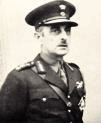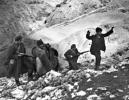|
|
 |

Themistoklis
Sophoulis, another of the Liberal old guard, formed a government at the end of 1945; then he announced that in March 1946
a national election would precede by two years the promised plebiscite on the monarchy. This decision inverted the order of
the two national ballots agreed upon in the Varkiza Agreement. The leftist parties, claiming that fair and impartial elections
were impossible in the prevailing climate of violence and repression, called a boycott of the election. When war-weary Greeks
went to the polls, their choice was limited by the decay of traditional parties under Metaxas. The election, which was marred
by low turnout and considerable fraud, gave power to the People's Party, a loose coalition of the old Populist Party with
Metaxasists, monarchists, and anticommunists. The new leader of the government was Konstantinos Tsaldaris, a nephew of the
prewar Populist leader.
The Tsaldaris regime renewed the persecution of the left, removing civil servants and university
professors from their posts because of their politics and accelerating the manhunts of rightwing bands. In 1946 over 30,000
men and women were interned in concentration camps or exiled. The country drifted ever closer to open civil conflict. Far
ahead of schedule, Tsaldaris demanded a plebiscite on the monarchy. Rather than waiting until 1948, as had been announced
by Sophoulis, he called for the referendum in September 1946. A highly suspect vote, which included coercion if not outright
rigging, restored the monarchy by 68 percent to 32 percent. For many Greeks, the restoration represented a betrayal of everything
they had fought for. Although there was widespread opposition to the idea of a communist government, there also was deep antipathy
to the monarchy in general and especially to King George, who had been tainted by his closeness to Metaxas. On the verge of
civil strife, the KKE resumed recruiting and began reassembling the nucleus of ELAS warriors who had fled into the mountains.

Civil War
In
December 1946, Markos Vafiadis announced the formation of a communist Democratic Army of Greece (DAG), the successor of the
ELAS. The DAG never exceeded 28,000 fighters, compared with about 265,000 troops in the national army and national police
force at the end of the war. The Civil War commenced in earnest during the winter of 1946-47. Vafiadis adopted a strategy
of guerrilla warfare, utilizing hit-and-run tactics to harass the national army and its allied groups. DAG forces scored some
notable successes, but they were unable to capture any major towns. Like almost all internecine conflicts, the Civil War was
marked by brutality on both sides. Villages were destroyed and civilians killed. The atrocities of the war left lasting scars
on the nation's consciousness.
By the spring of 1947, Britain no longer was able to meet Greece's
escalating demands for money and supplies, so the role of external patron was assumed by the United States. With the Greek case specifically in mind, Harry S. Truman set out
in March 1947 a policy of global containment of communist expansion that came to be known as the Truman Doctrine. Truman pledged
United States support to all free peoples
under the threat of communist takeover. Under that policy, the United States
made US$400 million in aid and military assistance available to Greece.
United States advisers and military personnel under General James van Fleet
came to Greece to train and supply the
national army and the security forces.
Although the disproportionate size of the forces had made the outcome of the
Civil War inevitable, the DAG's mistakes hastened its fall. After Vafiades was ousted by KKE chief Nikos Zahariadis in mid-1947,
the DAG made a disastrous shift from guerrilla tactics to conventional, set-piece battles. Outgunned and outmanned, the DAG
was pushed northward into the mountains.
In mid-1949, Yugoslav leader Josip Broz Tito inflicted another costly blow
by closing the supply routes through Yugoslavia
as part of his policy to conciliate the West. As the situation deteriorated, forced conscription of men and women and compulsory
evacuation of children eroded the DAG's popular base of support. The Civil War ended when the last DAG mountain stronghold
fell at the end of August. Thus, in addition to the more than 500,000 killed in World War II, during the Civil War 80,000
more Greeks lost their lives, 700,000 more became refugees, and the national economy was left in ruins.
After
World War II and the Civil War, Greece
was in a political and economic shambles. With massive United States
aid, however, new growth began almost immediately. Then, under Alexandros Papagos and Konstantinos Karamanlis, leaders of
new conservative coalition parties, political conditions stabilized and the economy experienced an extended growth period.
|
 |
|
|
Information taken by assorted internet sites! Many thanks to all of them.
|
|
|
 |

